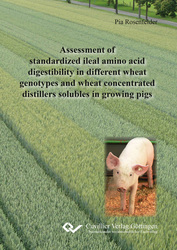| Areas | |
|---|---|
| Serie de libros (96) |
1379
|
| Nachhaltigkeit |
3
|
| Gesundheitswesen |
1
|
| Letra |
2367
|
| Ciencias Naturales |
5407
|
| Matemática | 229 |
| Informática | 319 |
| Física | 980 |
| Química | 1364 |
| Geociencias | 131 |
| Medicina humana | 243 |
| Estomatología | 10 |
| Veterinaria | 108 |
| Farmacia | 147 |
| Biología | 835 |
| Bioquímica, biología molecular, tecnología genética | 121 |
| Biofísica | 25 |
| Nutrición | 45 |
| Agricultura | 1004 |
| Silvicultura | 201 |
| Horticultura | 20 |
| Ecología y conservación de la tierra | 148 |
| Ciencias Ingeniería |
1793
|
| General |
98
|
|
Leitlinien Unfallchirurgie
5. Auflage bestellen |
|
Erweiterte Suche
Assessment of standardized ileal amino acid digestibility in different wheat genotypes and wheat concentrated distillers solubles in growing pigs (Tienda española)
Pia Rosenfelder (Autor)Previo
Indice, PDF (54 KB)
Lectura de prueba, PDF (89 KB)
Wheat is the primarily cereal grain produced within the European Union. Due to its high starch content it is the dominating energy feed ingredient in diets for pigs. However, due to its high dietary inclusion level wheat can also supply considerable high amounts of crude protein (CP) and amino acids (AA) to the animal. Wheat co-products of bioethanol production are a valuable source of CP and AA in animal nutrition. Therefore, the objectives of the present thesis were to study the nutritive value of eight recently introduced wheat genotypes and of one liquid wheat co-product of bioethanol production for growing pigs. For this purpose a comprehensive analysis of nutrients in the assay feedstuffs was conducted and standardized ileal digestibility (SID) of CP and AA in growing pigs was determined. There were significant differences in SID of CP and AA between the eight genotypes of wheat. However, digestibility values were lower when compared to literature data, leading to the assumption that data in actual feed tables might result in an overestimation of the protein value of wheat. The liquid wheat co-product is a valuable source of CP, AA and energy in diets for pigs. It is superior to dried bioethanol co-products as it is not exposed to excessive heat treatment during manufacturing resulting in greater digestibility values.
In der Europäischen Union ist Weizen die am weitesten verbreitete Getreideart. Aufgrund seines hohen Stärkegehalts wird Weizen in Mastschweinerationen als Energiefuttermittel eingesetzt. Bei hohen Anteilen in der Gesamtration kann Weizen jedoch auch einen erheblichen Beitrag zur Deckung des Rohprotein- (XP) und Aminosäuren (AS)- Bedarfs des Tieres leisten. Nebenprodukte aus der Weizenverarbeitung bei der Bioethanolproduktion sind eine wertvolle Eiweißkomponente in der Tierernährung, dazu zählen Trocken- und Flüssigschlempen. Ziele dieser Arbeit waren die Bestimmung des Futterwerts von 8 aktuell verfügbaren Weizengenotypen sowie eines flüssigen Weizenschlempefutters für Mastschweine. Zu diesem Zweck wurde eine umfangreiche Nährstoffanalyse der Versuchsfuttermittel durchgeführt, sowie die standardisierte praecaecale Verdaulichkeit (pcVQ) von XP und AS bei Mastschweinen untersucht. Es gab signifikante Unterschiede der pcVQ von XP und AS zwischen den 8 Weizengenotypen. Allerdings waren die Verdaulichkeitswerte geringer als in der Literatur angeben, so dass Daten aus aktuellen Futterwerttabellen möglicherweise den Proteinwert von Weizen überschätzen. Das flüssige Weizenschlempefutter stellt eine wertvolle XP-, AS- und Energiequelle für Schweine dar. Es ist Trockenschlempen im Nährwert überlegen, da es keiner intensiven Hitzeeinwirkung ausgesetzt ist und somit höhere Verdaulichkeitswerte aufweist.
| ISBN-13 (Impresion) | 9783954049462 |
| ISBN-13 (E-Book) | 9783736949461 |
| Formato | A5 |
| Idioma | Inglés |
| Numero de paginas | 154 |
| Laminacion de la cubierta | Brillante |
| Edicion | 1. |
| Lugar de publicacion | Göttingen |
| Lugar de la disertacion | Hohenheim |
| Fecha de publicacion | 11.03.2015 |
| Clasificacion simple | Tesis doctoral |
| Area |
Agricultura
|
| Palabras claves | amino acids, protein, digestibility, wheat, wheat by-products, pig |








